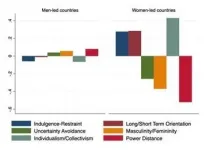(Press-News.org) UNIVERSITY PARK, Pa. -- A desalination membrane acts as a filter for salty water: push the water through the membrane, get clean water suitable for agriculture, energy production and even drinking. The process seems simple enough, but it contains complex intricacies that have baffled scientists for decades -- until now.
Researchers from Penn State, The University of Texas at Austin, Iowa State University, Dow Chemical Company and DuPont Water Solutions published a key finding in understanding how membranes actually filter minerals from water, online today (Dec. 31) in Science. The article will be featured on the print edition's cover, to be issued tomorrow (Jan. 1).
"Despite their use for many years, there is much we don't know about how water filtration membranes work," said Enrique Gomez, professor of chemical engineering and materials science and engineering at Penn State, who led the research. "We found that how you control the density distribution of the membrane itself at the nanoscale is really important for water-production performance."
Co-led by Manish Kumar, associate professor in the Department of Civil, Architectural and Environmental Engineering at UT Austin, the team used multimodal electron microscopy, which combines the atomic-scale detailed imaging with techniques that reveal chemical composition, to determine that desalination membranes are inconsistent in density and mass. The researchers mapped the density variations in polymer film in three dimensions with a spatial resolution of approximately one nanometer -- that's less than half the diameter of a DNA strand. According to Gomez, this technological advancement was key in understanding the role of density in membranes.
"You can see how some places are more or less dense in a coffee filter just by your eye," Gomez said. "In filtration membranes, it looks even, but it's not at the nanoscale, and how you control that mass distribution is really important for water-filtration performance."
This was a surprise, Gomez and Kumar said, as it was previously thought that the thicker the membrane, the less water production. Filmtec, now a part of DuPont Water Solutions, which makes numerous desalination products, partnered with the researchers and funded the project because their in-house scientists found that thicker membranes were actually proving to be more permeable.
The researchers found that the thickness does not matter as much as avoiding highly dense nanoscale regions, or "dead zones." In a sense, a more consistent density throughout the membrane is more important than thickness for maximizing water production, according to Gomez.
This understanding could increase membrane efficiency by 30% to 40%, according to the researchers, resulting in more water filtered with less energy -- a potential cost-saving update to current desalination processes.
"Reverse osmosis membranes are so widely used for cleaning water, but there's still a lot we don't know about them," Kumar said. "We couldn't really say how water moves through them, so all the improvements over the last 40 years have essentially been done in the dark."
Reverse osmosis membranes work by applying pressure on one side. The minerals stay there, while the water passes through. While more efficient than non-membrane desalination processes, this still takes an immense amount of energy, the researchers said, but improving the efficiency of the membranes could reduce that burden.
"Freshwater management is becoming a crucial challenge throughout the world," Gomez said. "Shortages, droughts -- with increasing severe weather patterns, it is expected this problem will become even more significant. It's critically important to have clean water available, especially in low resource areas."
The team continues to study the structure of the membranes, as well as the chemical reactions involved in the desalination process. They are also examining how to develop the best membranes for specific materials, such as sustainable yet tough membranes that can prevent the formation of bacterial growth.
"We're continuing to push our techniques with more high-performance materials with the goal of elucidating the crucial factors of efficient filtration," Gomez said.
INFORMATION:
Other contributors include first author Tyler E. Culp, Kaitlyn P. Brickey, Michael Geitner and Andrew Zydney, all of whom are affiliated with the Penn State Department of Chemical Engineering; Biswajit Khara and Baskar Ganapathysubramanian, both with the Department of Mechanical Engineering at Iowa State University; Tawanda J. Zimudzi of the Materials Research Institute (MRI) at Penn State; Jeffrey D. Wilbur and Steve Jons, both with DuPont Water Solutions; and Abhishek Roy and Mou Paul, both with Dow Chemical Company. Gomez is also affiliated with MRI. The microscopic work was conducted on electron microscopes in the Materials Characterization Lab in MRI. DuPont and the National Science Foundation funded the research.
Predicting when and how collections of particles, robots, or animals become orderly remains a challenge across science and engineering.
In the 19th century, scientists and engineers developed the discipline of statistical mechanics, which predicts how groups of simple particles transition between order and disorder, as when a collection of randomly colliding atoms freezes to form a uniform crystal lattice.
More challenging to predict are the collective behaviors that can be achieved when the particles ...
High in the clouds, atmospheric aerosols, including anthropogenic air pollutants, increase updraft speeds in storm clouds by making the surrounding air more humid, a new study finds. The results offer a new mechanism explaining the widely observed - but poorly understood - atmospheric phenomenon and provide a physical basis for predicting increasing thunderstorm intensity, particularly in the high-aerosol regions of the tropics. Observations worldwide have highlighted aerosols' impact on weather, including their ability to strengthen convection in deep convective clouds, like those ...
A new analysis suggests that, by 2040, 19% of the world's population - accounting for 21% of the global Gross Domestic Product - will be impacted by subsidence, the sinking of the ground's surface, a phenomenon often caused by human activities such as groundwater removal, and by natural causes as well. The results, reported in a Policy Forum, represent "a key first step toward formulating effective land-subsidence policies that are lacking in most countries worldwide," the authors say. Gerardo Herrera Garcia et al. performed a large-scale ...
When the COVID-19 pandemic reached Africa, the continent was already struggling to deal with another public health crisis - a growing cancer epidemic characterized by more than one million new cancer cases and nearly 700,000 deaths per year. In a Perspective, Beatrice Wiafe Addai and Wilfred Ngwa discuss the significant challenges COVID-19 imposed on cancer prevention and control in Africa and how the efforts to address these challenges highlight key opportunities where greater investment could improve cancer care globally. At the start of the pandemic, many African ...
Overcoming a key obstacle in achieving diamond-based electronic and optoelectronic devices, researchers have presented a new way to fabricate micrometer-sized diamonds that can elastically stretch. Elastic diamonds could pave the way for advanced electronics, including semiconductors and quantum information technologies. In addition to being the hardest materials in nature, diamonds have exceptional electronic and photonic properties, featuring both ultrahigh thermal and electric conductivity. Not only would diamond-based electronics dissipate heat more quickly, reducing the need for ...
CHAPEL HILL, NC--Boosting immune system T cells to effectively attack solid tumors, such as breast cancers, can be done by adding a small molecule to a treatment procedure called chimeric antigen receptor-T (CAR-T) cell therapy, according to a study by researchers at the UNC Lineberger Comprehensive Cancer Center. The boost helps recruit more immune cells into battle at the tumor site. The findings are published in the Journal of Experimental Medicine.
CAR-T immunotherapy, in which T cells are modified in the laboratory to express chimeric antigen receptors, CARs, that in turn target surface proteins ...
Producing clean water at a lower cost could be on the horizon after researchers from The University of Texas at Austin and Penn State solved a complex problem that has baffled scientists for decades, until now.
Desalination membranes remove salt and other chemicals from water, a process critical to the health of society, cleaning billions of gallons of water for agriculture, energy production and drinking. The idea seems simple -- push salty water through and clean water comes out the other side -- but it contains complex intricacies that scientists ...
Diamond is the hardest material in nature. But out of many expectations, it also has great potential as an excellent electronic material. A joint research team led by City University of Hong Kong (CityU) has demonstrated for the first time the large, uniform tensile elastic straining of microfabricated diamond arrays through the nanomechanical approach. Their findings have shown the potential of strained diamonds as prime candidates for advanced functional devices in microelectronics, photonics, and quantum information technologies.
The research was co-led by Dr Lu Yang, Associate Professor in the Department of Mechanical Engineering (MNE) at CityU and ...
AMES, Iowa - Nature has figured out how to make great membranes.
Biological membranes let the right stuff into cells while keeping the wrong stuff out. And, as researchers noted in a paper just published by the journal Science, they are remarkable and ideal for their job.
But they're not necessarily ideal for high-volume, industrial jobs such as pushing saltwater through a membrane to remove salt and make fresh water for drinking, irrigating crops, watering livestock or creating energy.
Can we learn from those high-performing biological membranes? Can we ...
Countries led by women have not fared significantly better in the COVID-19 pandemic than those led by men- it may be just our Western media bias that makes us think they have!
INFORMATION:
Article Title: "Gender in the time of COVID-19: Evaluating national leadership and COVID-19 fatalities"
Funding: The author(s) received no specific funding for this work.
Competing Interests: The authors have declared that no competing interests exist.
Article URL: https://journals.plos.org/plosone/article?id=10.1371/journal.pone.0244531
...




